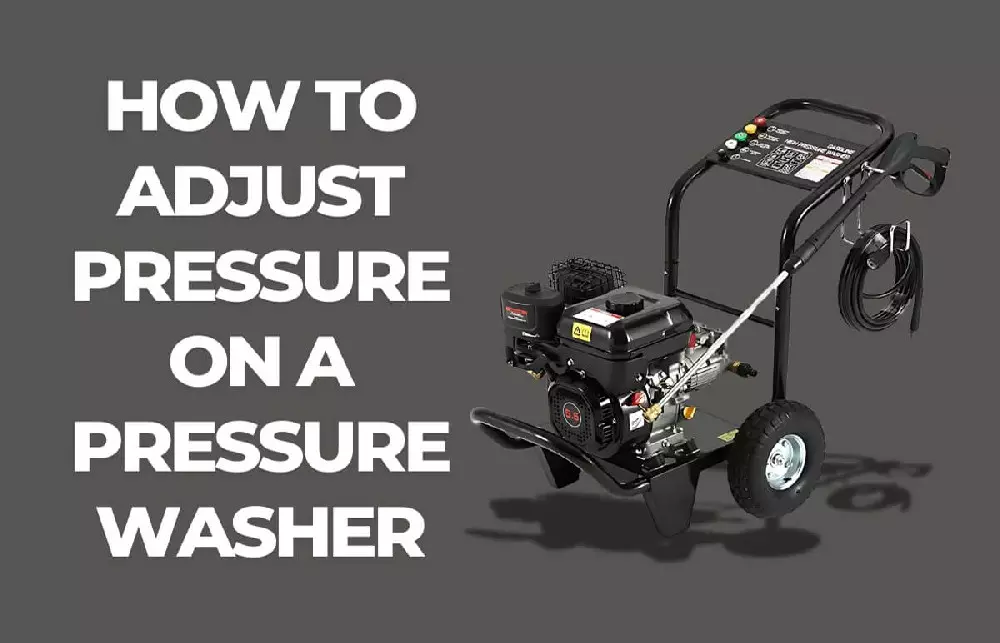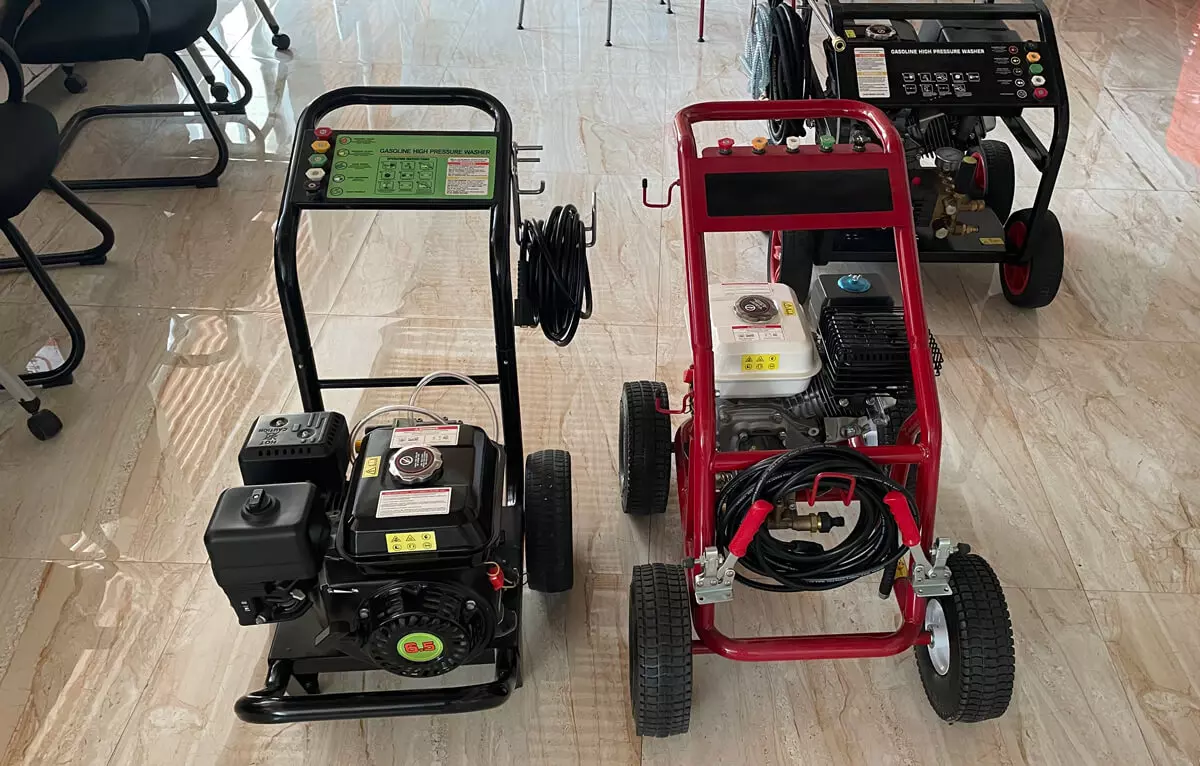How to adjust the pressure on a pressure washer
2025-05-15
Table of content
Pressure washers are powerful cleaning devices that use high-pressure water to remove dirt, grime, mold, and stains from various surfaces. They work by pressurizing ordinary water through a pump system, creating a forceful spray that cleans far more efficiently than traditional scrubbing.
Want to get the most out of your pressure washer? This article will show you how to adjust the pressure properly to match different tasks and extend the life of your machine.
Understanding how to fine-tune pressure settings helps you clean more effectively while protecting delicate surfaces and the washer itself.

Understanding pressure settings in pressure washers
What Are PSI and GPM? When using a pressure washer, you'll frequently encounter two important measurements: PSI and GPM. These values determine your machine's cleaning effectiveness:
PSI (Pounds per square inch)
This measures the force of the water coming out of your pressure washer. Think of PSI as the "pushing power" of your machine. Higher PSI means more power to blast away stubborn dirt and grime. However, more pressure isn't always better—while 1200 PSI is safe for car windows and furniture, 2000 PSI could cause damage to those same surfaces.
GPM (gallons per minute)
This indicates how much water flows through your pressure washer each minute. Consider GPM as the "washing power" of your machine. Higher GPM improves rinsing and helps carry away debris more efficiently. When combined with high PSI, it makes dirt removal much easier.
Why might you need to adjust your pressure?
You may need to adjust the pressure on your pressure washer for several reasons, with the most common being the type of surface you are cleaning.
For example, you’ll need more pressure to clean a sidewalk covered in mold and mildew than for wicker patio furniture with light dirt. Too much pressure can damage delicate surfaces like wicker.
While the same pressure washer can handle both tasks, it’s best to adjust the pressure based on the surface and how much force is needed to clean it effectively.
The goal is to find the sweet spot—enough pressure to clean thoroughly without causing damage. Before starting a cleaning project, it’s always smart to check or research the recommended PSI for your specific task.
Some general guidelines include:
3000 PSI for concrete
2500 to 4000 PSI for decks and docks
3000 to 4000 PSI for ATVs, boats, asphalt, and similar surfaces
4000 PSI for stripping paint
1200 to 1600 PSI for vinyl surfaces
1200 to 1900 PSI for cars
1500 PSI for motorcycles, bikes, and scooters
How do I adjust the pressure on my pressure washer?
Adjusting the pressure output of your pressure washer allows you to tailor the cleaning effort to different surfaces. Whether you're cleaning delicate siding or sandblasting away stubborn concrete stains, it's vital to know how to adjust the pressure on your machine.
In most cases, pressure washers can be adjusted through nozzles, valves, and a host of other features that may already be built into your pressure washer. If you're still figuring out the exact pressure of your pressure washer, there's a pressure gauge attachment you can use.
But the pressure washer you buy may be different from another model. It always helps to read your manual and be knowledgeable. Here's how to adjust the pressure on your pressure washer.
Use unloader valve
The unloader valve is a critical component for regulating pressure in your pressure washer. It reacts to changes in water flow or pressure and redirects water through the bypass when the trigger on the spray gun is released. This prevents pressure buildup that could damage the pump.
Pressure control: On many pressure washers, the unloader valve can be adjusted to set the maximum pressure level.
Adjustment: Most unloader valves feature an adjustment screw or knob. Turning it clockwise typically increases pressure, while counterclockwise decreases it.
Caution: Make small, quarter-turn adjustments at a time, testing the pressure after each change. Over-tightening can damage the valve or create unsafe pressure levels.
Always consult your owner's manual before adjusting the unloader valve, as improper adjustment can lead to machine damage or safety hazards.
Selecting the right nozzle
One of the simplest ways to control pressure is by changing spray nozzles. Most pressure washers include a set of nozzle tips with different spray angles designed for specific tasks. While the PSI at the pump remains the same, the spray angle affects how that pressure is applied.
The pressure increases with a narrower tip angle and decreases with a broader one. A 40° nozzle delivers gentler cleaning than a 0° nozzle, which produces a pinpoint spray with maximum force.
Most nozzles are color-coded for easy identification:
Red (0°): Pinpoint spray with maximum pressure for tough stains (use with extreme caution)
Yellow (15°): Narrow spray for heavy-duty cleaning of concrete and hard surfaces
Green (25°): General-purpose cleaning for driveways, siding, and decks
White (40°): Wide spray for more delicate surfaces and vehicle washing
Black (65° or soap): Low-pressure nozzle for applying detergent
Adjustable nozzles: Some pressure washers feature a single adjustable nozzle that allows you to twist and change the spray pattern from wide to narrow, eliminating the need to switch tips.
Using pressure regulator knobs
Many mid-range and premium pressure washers include dedicated pressure regulator knobs. Typically found on the pump assembly or near the outlet where the high-pressure hose connects.
Turn the knob clockwise to increase pressure or counterclockwise to decrease it. Some models feature clear markings or a pressure gauge.
These knobs let you adjust pressure without interrupting your work or changing nozzles—ideal when cleaning varied surfaces in one session.
Adjusting engine speed (Gas-powered units)
For gas-powered pressure washers, engine speed directly influences pressure output.
Most units have a throttle lever. Lower RPMs reduce pump speed and water pressure. However, lower engine speed is useful for delicate tasks, conserving fuel and reducing noise.
Switching to idle during short breaks reduces pressure and prevents unnecessary wear on the pump.
Practical tips for pressure adjustment
The goal is to find the minimum effective pressure for your task:
Begin with less pressure than you think you need and increase gradually. Consider using detergents for better results at lower pressures.
Always test your pressure settings on a small, inconspicuous spot to ensure no damage.
The distance between the nozzle and surface affects pressure. Moving closer to the surface increases pressure, while moving further away reduces it. If the pressure isn't strong enough to remove dirt, try getting closer to the surface.
Unusual sounds or vibrations when adjusting pressure could indicate problems that need attention.
Troubleshooting common problems
Although using a pressure washer is generally straightforward, common problems can arise during operation. Understanding how to solve them can help ensure a smooth cleaning experience. Here are some common issues and their solutions:
Inadequate pressure
If your pressure washer's pressure is lower than expected, check the following:
Ensure the water supply is adequate and the hose is not kinked or blocked.
Check if the nozzle is clogged or improperly attached.
If these steps don't resolve the issue, refer to the manufacturer's manual for specific troubleshooting steps.
Fluctuating pressure
Fluctuating pressure may indicate a problem with the water supply or the washer itself. Check for:
Stable water supply and no blockages or air leaks in the hose or connections.
A clogged inlet filter (clean if necessary).
If the issue persists, a pump malfunction may be the cause, and professional inspection is recommended.
Excessive pressure
Excessive pressure can be a safety hazard and may damage surfaces. To resolve this: Ensure the pressure adjusting knob is set correctly. If pressure remains too high, the unloader valve or regulator may be faulty. Professional repair may be needed.
Leaks
Leaks can occur in various parts of the pressure washer. Check:
All connections (spray wand, hose, and fittings) for signs of leakage.
Tighten or replace damaged components as needed.
If the leak persists, it may indicate a more serious issue with seals, valves, or the pump. Professional repair is recommended.
Poor spray pattern
An uneven or irregular spray pattern often indicates nozzle issues. Check if:
The nozzle is clogged or worn out.
The nozzle is properly aligned with the spray wand.
Clean or replace the nozzle if necessary to restore a consistent spray.
By troubleshooting common problems and fixing them quickly, you can maintain optimal performance and extend the life of your pressure washer. Regular maintenance, including cleaning and inspecting connections, can help prevent these issues from occurring.
Conclusion
Using the appropriate pressure setting directly impacts your cleaning efficiency. Too little pressure may leave you scrubbing unnecessarily, while excessive pressure risks damaging surfaces or stripping paint.
Each pressure washer model has unique features and specifications. We recommend consulting your machine's manual for manufacturer-specific guidelines on pressure adjustment, maintenance, and safety protocols.
As a leading pressure washer manufacturer with over 15 years of experience, we at BISON are committed to engineering reliable, efficient cleaning equipment that meets the highest international standards. Our professional-grade pressure washers combine innovative technology, durable construction, and user-friendly design for exceptional cleaning power in both commercial and residential applications.
Ready to experience the difference that proper pressure adjustment and quality equipment can make in your cleaning routine? Explore our complete range of pressure washers, accessories, and replacement parts. Our team of cleaning experts is available to help you select the right model for your needs and provide ongoing support for all your pressure washing requirements.


